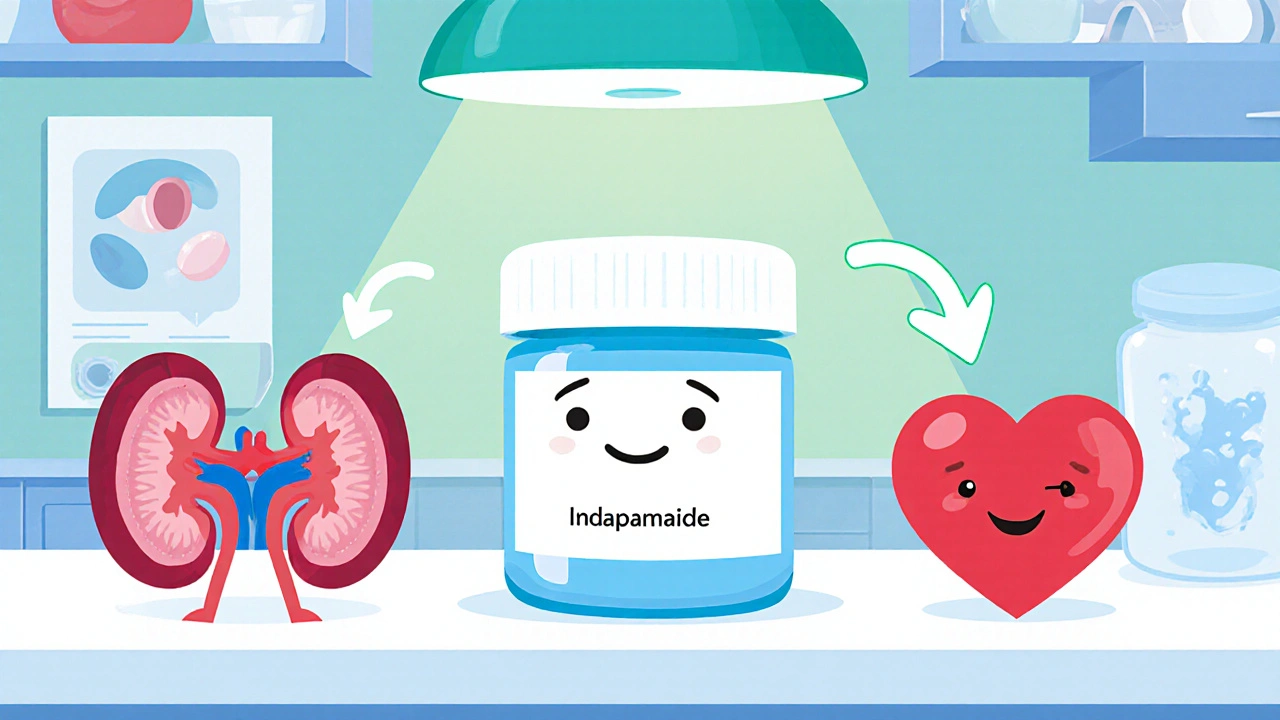What is Indindapamide and Why It Matters
When you hear the name Indapamide is a thiazide‑like diuretic used to control high blood pressure and fluid retention, the first question is often "is it safe?" The answer depends on how your body reacts, which other medicines you take, and whether any underlying conditions amplify the drug’s impact.
This article breaks down every angle of Indapamide side effects you should watch, from the everyday tingles to the red‑flag symptoms that demand a doctor’s call.
How Indapamide Works in Your Body
Indapamide belongs to the Thiazide‑like diuretics class. It tells the kidneys to let more sodium and water leave the bloodstream, which reduces blood volume and eases pressure on the heart.
Because it also relaxes the smooth muscle in blood vessels, you get a double‑action drop in blood pressure. The result is smoother circulation and lower risk of strokes or heart attacks for many patients.
Common (Mild) Side Effects
Most people feel fine, but up to one in three users notice at least one of these subtle signals:
- Dizziness or light‑headedness, especially when you stand up quickly
- Headache that eases after a few days
- Dry mouth or increased thirst
- Minor muscle cramps, often linked to low potassium levels
- Frequent urination, especially in the first weeks
These symptoms usually fade as your body adjusts. Staying hydrated (but not over‑hydrated) and eating potassium‑rich foods like bananas can help.
Less Common (Moderate) Side Effects
About 5-10 % of patients report the following:
- Persistent low sodium (hyponatremia) causing nausea, confusion, or fatigue
- Elevated blood sugar, which can be a concern for diabetics
- Joint pain or swelling, sometimes confused with gout attacks
- Skin rashes or itching, signaling a mild allergic reaction
If any of these linger beyond a week, contact your healthcare provider for a dosage tweak or blood‑test check.

Rare (Serious) Side Effects You Must Never Ignore
Serious reactions are uncommon (<1 %) but can be life‑threatening:
| Side Effect | Warning Signs |
|---|---|
| Severe allergic reaction (anaphylaxis) | Difficulty breathing, swelling of face or throat, hives |
| Acute kidney injury | Significant drop in urine output, swelling in ankles, sudden weight gain |
| Severe electrolyte imbalance | Irregular heartbeat, muscle weakness, seizures |
| Pancreatitis | Upper‑abdominal pain radiating to the back, vomiting, elevated enzymes |
Any of these symptoms warrants immediate emergency care.
Who Is More Likely to Experience Problems?
Understanding risk factors helps you anticipate issues before they start:
- Kidney function impairment - the drug is cleared through the kidneys, so reduced function raises blood levels.
- Pre‑existing electrolyte imbalance, especially low potassium or magnesium.
- History of gout - diuretics can raise uric acid, triggering attacks.
- Older adults - they tend to have slower metabolism and are more sensitive to blood‑pressure drops.
- Concurrent use of NSAIDs (ibuprofen, naproxen) - these can blunt the diuretic effect and raise kidney risk.
If any of these apply, your doctor may start you at a lower dose or monitor labs more closely.
Managing Mild Side Effects at Home
Most day‑to‑day discomfort can be tamed with simple habits:
- Hydration balance: Drink enough water to replace losses, but avoid gulping large volumes right before bed to reduce nighttime trips to the bathroom.
- Potassium boost: Incorporate bananas, oranges, spinach, or a low‑dose potassium supplement if your doctor approves.
- Gradual position changes: Rise slowly from sitting or lying to prevent dizziness.
- Monitor blood pressure: Keep a log; if readings stay unusually low, call your provider.
- Dietary sodium: A moderate‑salt diet helps the drug work efficiently without triggering hyponatremia.
Documenting these steps also gives your clinician concrete data for any follow‑up visits.

When to Seek Immediate Medical Attention
Never wait if you notice any of the following:
- Severe shortness of breath or chest pain
- Sudden, sharp swelling in the legs or abdomen
- Irregular heart rhythm (fast, slow, or skipped beats)
- Persistent vomiting or severe diarrhea
- Extreme fatigue combined with confusion or visual changes
These could signal a dangerous electrolyte shift or kidney issue that needs urgent care.
Key Drug Interactions to Watch
Indapamide doesn’t work in isolation. Some medicines amplify its effects, while others blunt them:
- ACE inhibitors & ARBs: Boost blood‑pressure lowering, increasing the risk of low blood pressure.
- Lithium: Reduced clearance can raise lithium levels, leading to toxicity.
- Other diuretics: Stacking can cause severe electrolyte loss.
- Antidiabetic drugs: May need dose adjustment because diuretics can raise blood glucose.
Always present a full medication list to any new prescriber.
Practical Tips for Safe Use
- Take the pill as prescribed, usually once daily in the morning.
- Schedule regular blood tests (electrolytes, kidney markers) every 3-6 months.
- Keep a symptom diary during the first month - note blood pressure, urination frequency, and any unusual feeling.
- Ask your pharmacist for a medication‑interaction check if you add over‑the‑counter supplements.
- If you miss a dose, take it as soon as you remember unless it’s close to the next dose; never double up.
Following these habits reduces surprise side effects and keeps your treatment on track.
Frequently Asked Questions
Can I take Indapamide if I’m pregnant?
Indapamide is generally avoided during pregnancy because it can affect fetal kidney development and reduce amniotic fluid. Talk to your obstetrician about safer alternatives for blood‑pressure control.
How long does it take for side effects to disappear?
Mild symptoms like dizziness or increased urination usually settle within 1-2 weeks as your body adapts. Persistent or severe effects warrant a doctor’s review.
Do I need to stop taking Indapamide before surgery?
Yes, most surgeons ask patients to pause diuretics 24-48 hours before the operation to avoid sudden fluid‑shifts and low blood pressure during anesthesia.
Is Indapamide the same as Hydrochlorothiazide?
Both are thiazide‑like diuretics, but Indapamide has a longer half‑life and a slightly different side‑effect profile. Your doctor will choose based on your specific health picture.
Can I drink alcohol while on Indapamide?
Alcohol can increase dizziness and low‑blood‑pressure effects, so limit intake and never drink heavily, especially when you’re still adjusting to the medication.
Staying informed about Indapamide side effects empowers you to catch issues early, keep blood pressure in check, and avoid unnecessary complications. If you have any lingering doubts, a quick chat with your healthcare provider is the safest next step.


Comments
JessicaAnn Sutton
While the pharmacological profile of Indapamide is undeniably effective for hypertension, one must not overlook the ethical responsibility of prescribing clinicians to vigilantly monitor electrolyte disturbances. The literature repeatedly emphasizes that even "mild" side effects, such as hypokalemia, can precipitate severe cardiac arrhythmias if unaddressed. Consequently, patients should be counseled with precise dietary guidelines, not merely a cursory suggestion to "eat bananas." Moreover, the moral imperative to obtain baseline blood panels cannot be overstressed, lest we compromise the very standards of medical integrity.
October 20, 2025 at 13:00
Israel Emory
Indeed, the article presents useful data, however, it fails to stress the urgency, the necessity, and the practical steps patients must take, which is simply unacceptable; you deserve a clear, actionable plan, not a vague reassurance, and clinicians should therefore adopt a more proactive stance, ensuring frequent electrolyte monitoring, patient education, and dosage adjustments.
October 22, 2025 at 01:07
Sebastian Green
I’ve felt a bit dizzy after starting Indapamide, but staying hydrated helped.
October 23, 2025 at 13:14
Wesley Humble
From a mechanistic standpoint, Indapamide’s dual action on sodium reabsorption and vascular smooth muscle relaxation warrants a comprehensive risk–benefit analysis, particularly in polypharmacy contexts; failure to account for synergistic hypotensive effects may culminate in orthostatic intolerance, a scenario best avoided through meticulous titration 📊. Additionally, the prevalence of hyperglycemia, albeit modest, should prompt periodic glycated hemoglobin assessments, especially in patients with antecedent glucose dysregulation 😊. Such diligence aligns with evidence‑based practice standards, thereby mitigating iatrogenic complications.
October 25, 2025 at 01:20
barnabas jacob
Yo, the whole indapamide thing is basically a diuretic that messes with Na+ and K+ balance, so if you dont watch yer electrolytes you can end up with some serious arrhythymia, which is def not something you want. Also, the drug can cause hyponatremia, leading to confushion and fatigue – pretty nasty side effect that many docs just brush off as "common". So make sure u get those labs done, otherwise u might be playing Russian roulette with your heart.
October 26, 2025 at 12:27
jessie cole
Listen, you are not alone in this battle against hypertension, and with the right guidance you can turn the tide! Imagine your body as a finely tuned orchestra, where each electrolyte plays its part; when Indapamide is introduced, you must ensure the potassium section stays strong. Follow a diet rich in bananas, leafy greens, and stay vigilant with your doctor’s recommendations – this is your anthem of triumph, and together we will conquer those side effects.
October 28, 2025 at 00:34
Kirsten Youtsey
One must consider the broader pharmaco‑industrial agenda that subtly promotes the widespread use of thiazide‑like diuretics, including Indapamide, without adequately disclosing the long‑term metabolic ramifications. The selective funding of studies that downplay rare but severe adverse events suggests an orchestrated narrative, tailored to maintain market dominance. Consequently, a discerning reader should scrutinize the data, question the absence of independent replication, and remain vigilant against potential covert bias.
October 29, 2025 at 12:40
Matthew Hall
Man, it's like they want us to think a few extra trips to the bathroom are nothing, but behind the curtain there's this whole secret plot to keep us dependent on constant medication. The way the side‑effects are downplayed feels like a scripted drama, and I'm just waiting for the next twist where they reveal some hidden ingredient that messes with our sleep cycles. Seriously, if you're feeling weird, don't just shrug it off – speak up, because the silence is part of their plan.
October 31, 2025 at 00:47
Demetri Huyler
Indapamide, as a component of the modern antihypertensive arsenal, exemplifies the ingenuity of American pharmaceutical research, yet its adoption must be tempered with a sober appreciation of its physiological ramifications. First, the drug’s capacity to promote natriuresis offers undeniable benefits for patients grappling with volume overload, a testament to the meticulous design of thiazide‑like agents. However, this very mechanism can precipitate electrolyte imbalances, notably hypokalemia, which, if unchecked, may set the stage for ventricular ectopy and sudden cardiac events. Moreover, the reduction in plasma volume can exacerbate orthostatic hypotension, a concern for elderly individuals who comprise a substantial segment of the hypertensive population. In clinical practice across the United States, guidelines advocate for baseline serum electrolytes, renal function tests, and periodic monitoring-a protocol that should be regarded as non‑negotiable. Physicians must also recognize the drug’s propensity to modestly elevate blood glucose, a factor that can complicate management in patients with comorbid diabetes mellitus, a condition whose prevalence is alarmingly high in our nation. The interplay between Indapamide and concurrent medications, such as non‑steroidal anti‑inflammatory drugs, can further diminish renal perfusion, thereby demanding a careful reconciliation of therapeutic regimens. From a public health perspective, the widespread prescription of Indapamide reflects both the successes and challenges of our healthcare system: we achieve blood pressure control at scale, yet we must allocate resources for comprehensive patient education and follow‑up. Failure to do so risks undermining the very gains we celebrate. It is incumbent upon clinicians, pharmacists, and policymakers to uphold rigorous standards, ensuring that the promise of this medication is fulfilled without compromising safety. Finally, let us not forget that the United States, as a leader in medical innovation, bears the responsibility to set a global example by championing transparency, fostering patient‑centered care, and rigorously evaluating drug safety profiles. By adhering to these principles, we honor the trust placed in us by every American who depends on Indapamide to navigate the treacherous waters of hypertension. Regular follow‑up visits should incorporate symptom review, blood pressure trends, and an assessment of any emerging adverse effects. Patients who experience persistent dizziness or muscle cramps should have their potassium levels rechecked promptly to preempt more serious complications. Ultimately, the judicious use of Indapamide embodies the balance between therapeutic efficacy and patient safety-a balance that defines the very essence of American medicine.
November 1, 2025 at 12:54